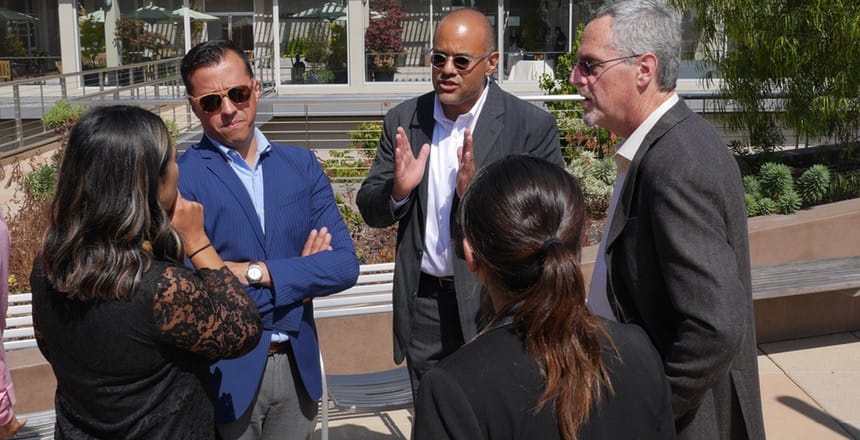
By Andrew Cohen
When approached about training top Mexican law students and professors to help implement the nation’s new criminal justice system, Berkeley Law faculty members jumped at the chance.
“This is such an important project for Berkeley Law to be affiliated with because we’re the premier public law school in the United States, we share a border with Mexico and we rightly view our public mission as extending beyond our small corner of the world,” Professor Andrea Roth said. “It’s also a critical moment for ensuring successful historic reforms in Mexico.”
Funded by the U.S. State Department in October 2014, a cooperative initiative between the two nations is helping the students and professors understand Mexico’s transition to US-like oral adversarial trials. The change, already underway, takes Mexico away from its written inquisitorial system, which has been criticized for being cumbersome and lacking transparency.
Led by the organization Justice in Mexico, the Oral Adversarial Skill-building and Immersion Seminar (OASIS) program provides law professors and students from the Universidad Nacional Autónoma de México (UNAM) with litigation workshops, educational tours and symposiums—and the knowledge to teach others.
Last week—just two months after Mexico’s new trial procedures went into effect—a 10-member UNAM delegation spent two days at Berkeley Law. They attended presentations by Roth on forensic evidence law and Charles Weisselberg on police interrogations, observed an international human rights law class taught by Saira Mohamed and discussed criminal justice reform in Mexico and Latin America with LL.M. students.
Justice for Mexico Director David Shirk, a University of San Diego professor, lauded the chance for his delegation “to learn from stellar professors who teach not only from the textbook, but from practical experience. We’ve wanted to collaborate with Professor Weisselberg, who played a key role in bringing our group to Berkeley, for many years. He really understood the importance of what we’re trying to do.”
Shirk called it a crucial opportunity for UNAM to “develop contacts and connections with one of the foremost law programs in the United States. The visit provided a great forum for discussion about the future of efforts to reform Mexico’s criminal justice system.”
The delegation’s visit to Berkeley Law was part of a 12-day Bay Area trip organized by Training Course Director Janice Deaton, a highly-experienced defense lawyer. The participants also attended live court proceedings; interacted with judges, prosecutors, public defenders and criminal defense attorneys; and learned from other legal experts about our adversarial system.
Previous training trips took place in Washington, D.C., Boston and San Diego. Over the past two summers, the OASIS program has brought more than 60 UNAM faculty and students to the U.S., out of the nearly 500 that the program has trained in Mexico City.
“This is an enormously important reform effort for Mexico,” Weisselberg said. “It’s a privilege to work with Justice in Mexico to help train these lawyers and professors as they advance the process of change.”
Inside police interrogations
The escalation of violence in Mexico has greatly increased the number of atrocities, botched criminal investigations and police abuses. Weisselberg’s presentation on police interrogations—and the impact of Miranda v. Arizona 50 years after the U.S. Supreme Court ruling—sparked clear interest and myriad questions from the Mexican visitors.
Weisselberg laid out the police procedure questions that all criminal justice systems must decide: Can a suspect be questioned? Who does the questioning? Can a person refuse to answer? What law enforcement conduct is permissible during questioning? How do we regulate police and prosecutors? What is the role of courts and the defense lawyer? When is a statement considered evidence?
He further explained the contrasting approach in the U.S. between an initial police interview—open-ended and conversational—and an ensuing interrogation, where guilt is presumed. His presentation included a video where police officers cited the key components of a strong interrogation: developing themes that justify or excuse the conduct in order to glean a confession, interrupting denials and showing understanding to build rapport.
“We frankly haven’t regulated police interrogations very well here in the U.S.,” Weisselberg said, noting the unchecked use of psychological tactics and deceptive practices that often manipulate a suspect’s perceptions of his or her choices. “It’s tough for courts to understand the impact of implied threats or promises that interrogators make, and our cases haven’t recognized this imbalance of power. Courts mostly look for an express threat to the suspect (to deem an interrogation behavior illegal).”
As for the iconic Miranda warnings, Weisselberg explained how they are often used within the interrogation process rather than beforehand. He also noted that police often say, “I just want to talk with you, you’re not under arrest,” in order to avoid having to advise a suspect of the Miranda rights. Moreover, studies have showed that the complete Miranda warnings vary widely in length and complexity—which challenges the assumption that everyone who receives warnings can fully comprehend their meaning.
The Mexican delegation paid rapt attention as Weisselberg compared the U.S. system to those in Europe and in Japan, and spelled out some of the key challenges.
“It’s gratifying to see that many of these faculty and students have come away very inspired to do more work on criminal justice,” said Shirk, who helped launch the Justice in Mexico program 15 years ago—initially as a policy-focused research initiative. “That’s especially important for the students who will go on to become the future operators of Mexico’s criminal justice system.”